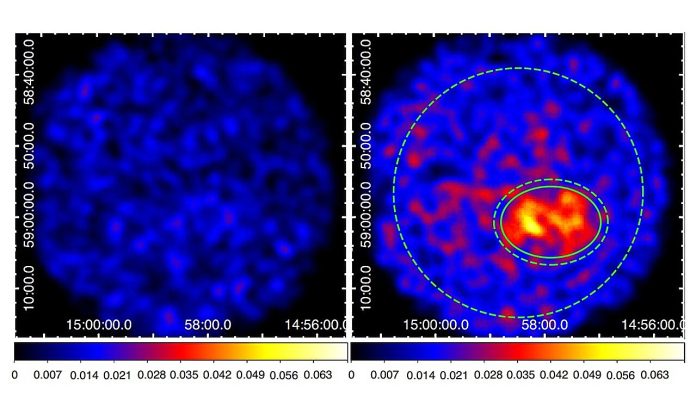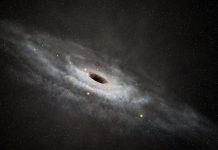
Scientists have identified a mysterious X-ray source, known as AX J145732−590 located far beyond our own Milky Way. Observations using X-ray telescopes suggest this object, previously hidden by the dense material within our galaxy, is a large collection of galaxies
An enigmatic X-ray source, lurking behind the dense expanse of our Milky Way galaxy’s plane, has finally revealed its true identity. For years designated as AX J145732−5901, this celestial object, first spotted in 2001 during an X-ray survey by the now-retired Advanced Satellite for Cosmology and Astrophysics (ASCA), has long puzzled astronomers.
Initial observations hinted at an extended and heavily absorbed source, leading to the suspicion that it might be a cluster of galaxies obscured by the galactic plane. Now, a detailed analysis of data from the Suzaku satellite, conducted by a team of Japanese astronomers, has provided compelling evidence confirming this hypothesis.
Peering through the galactic haze with Suzaku
Led by Shigeo Yamauchi from Nara Women’s University in Japan, the research team meticulously re-examined ASCA data of AX J145732−5901, leveraging the insights gained from Suzaku satellite observations of the Galactic ridge X-ray emission and the Cosmic X-ray background. Their findings, published on the arXiv preprint server, paint a clear picture of a massive structure residing far beyond our galaxy.
The analysis revealed that AX J145732−5901 exhibits a significant extended X-ray emission, stretching across an area of 14 by 10 arcminutes. At the estimated distance of 1.8 billion light-years, this angular size translates to an enormous physical extent of 5.87 by 4.24 million light-years. The elongated shape of the emission, oriented east-west, and the presence of local substructures suggest a dynamic and potentially ongoing merging process within the cluster.
Spectral fingerprints of a distant giant
Further bolstering the cluster identification is the unique X-ray spectrum of AX J145732−5901. The spectrum displays a prominent emission line at 5.94 keV, a characteristic feature often observed in galaxy clusters. Crucially, the X-ray emission is found to be heavily absorbed by interstellar matter, with a hydrogen column density significantly exceeding that of our own galaxy in that direction. This substantial absorption strongly indicates that the source lies far beyond the Milky Way.
The calculated X-ray luminosity of AX J145732−5901 in the 1–10 keV energy band is an astounding 260 tredecillion erg/s. Combined with the estimated angular distance, this luminosity firmly places the object in the realm of galaxy clusters.
An unrelaxed giant behind the veil
Based on their comprehensive analysis, the researchers confidently conclude that AX J145732−5901 is indeed a cluster of galaxies situated behind the galactic plane. The observed X-ray morphology, with its elongated shape and substructures, further suggests that this is an “unrelaxed” or merging cluster, a system still undergoing the violent gravitational interactions of its constituent galaxies.
The team also provided estimations for the cluster’s mass. They calculated the total gas mass to be approximately 30 trillion solar masses. Assuming that the gas constitutes about 15% of the total mass in typical galaxy clusters, the total mass of AX J145732−5901 is estimated to be a staggering 200 trillion solar masses. This discovery highlights the power of X-ray astronomy in piercing through the obscuring dust and gas of our galaxy to unveil the grand structures populating the distant universe.










